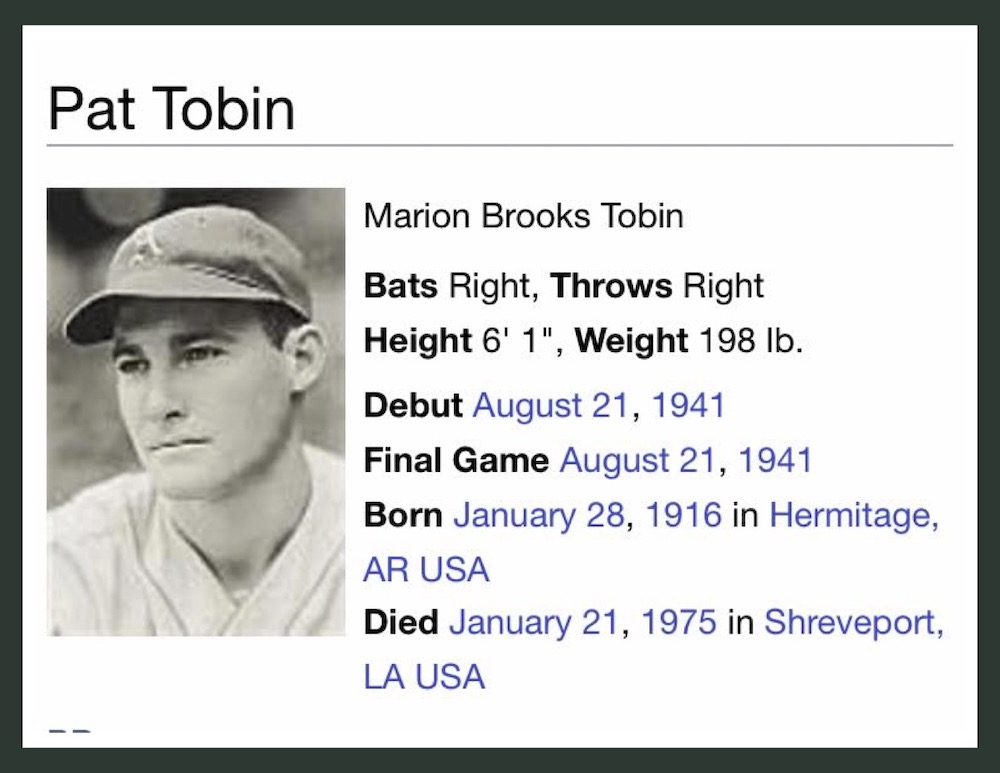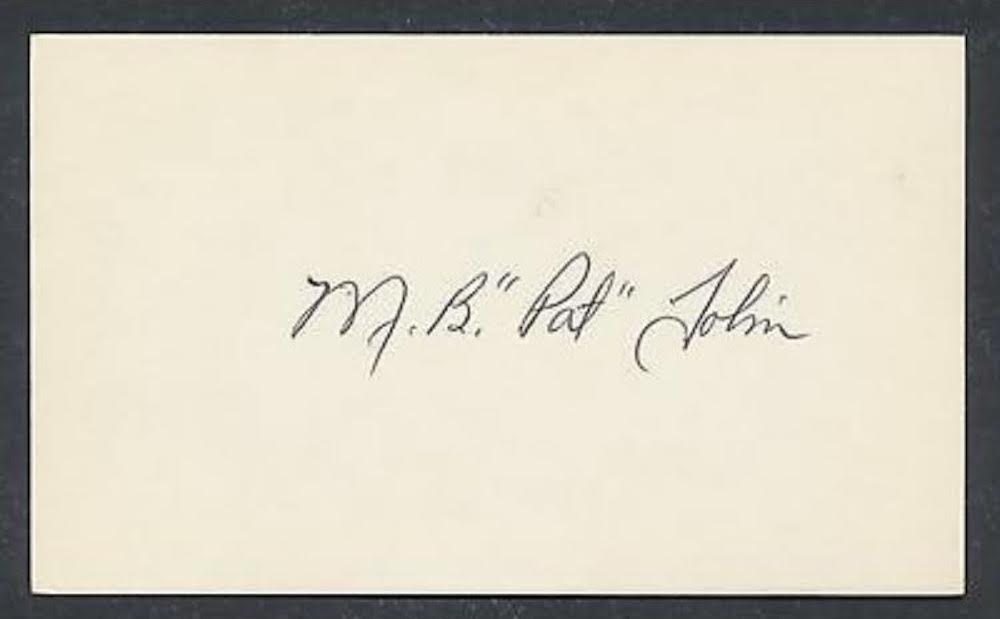It’s that time – a Pastime that comes around every October when most regular sports take a “back seat” at least temporarily to the Major League World Series.

Each fall, years ago, if you could ‘sit still’ and “listen,” Wayne’s around such baseball lovers as Paul Whitaker, Jimmy Russell, Wayne Wisener, Hugh Allen Jones, Tommy Dunaway, Wilmer M. Love, Martin Hankins Jr., Bob Tate. Watt Childs and others, to find out how much these local men (and others who may have drifted by) knew of the two teams in the World Series.
Most of these intense discussions over a cup of coffee were of the baseball players who were once roaming the infields and outfields at Ray Winder Field up in Little Rock. Either the players they discussed were on the Travelers or playing against the Little Rock home team back in the old Texas League as it was known in the 1950s to 1990s.
And one great discussion often came about the former Bradley Countians, the Tobin boys, especially a Marion Brooks Tobin, known in baseball circles as “Pat” Tobin, who had a short, but real Major League Baseball short appearance, often called a “Cup of Coffee,” moment.
What a Bradley County native who played Major League Baseball!
As an excited 15-year-old, I simply blurted out my surprise one lazy late fall afternoon at Wayne’s during a “coke break” from work at the Eagle Publishing Company.

Russell, who usually had been out all-day at his business Warren Monument Company, before dropping by Lumberjack football practice. He had been polishing granite grave markers at his shop in West Warren and always had a fine coating of white dust all over his khaki pants and plaid shirt. He simply smiled to his table group of Hankins, Love and Clint Huey, over the question of a Major Leaguer from Bradley County.
With both Whitaker and Wisener bustling about in the eatery, but keeping both the coffee and ice water flowing and interjecting their own likes or dislikes of the World Series players for the crowd. These two, while not at the tables sitting with the rest of the crowd, stayed riveted onto the talk of major league baseball.
I got a lesson that day on the Tobin family who once hailed from Hermitage, had boys who played in the lower rungs of Major League baseball, but “Pat” as Russell so glowingly said, “had a shot, not a fair shot, but he did get to the majors, but didn’t hang around very long.”
Both Russell and Wisener recalled: “He’s a righty, bats right and throws a change-up, not bad for a right hander,” was their joint assessment.
The question answered, the talk went back to the upcoming World Series.
So, for the next 50 plus years, I filed away this Pastime memory of a major league baseball player from my home county… until recently.
Jim Yeager of Russellville, a noted baseball researcher, was on a recent podcast run by Tom Dillard and Tim Nutt, who of the state’s revered historians talked about baseball.
Yeager promoted his recent book, “Backroads and Ballplayers: A Collection of Stories about Famous (and not so famous) Professional Baseball Players from Rural Arkansas.” I bought the book and was rewarded with an entire chapter on Pat Tobin of Hermitage.
The story, in all reality, has a start in Bradley County’s second largest city, Hermitage, with Annie and Cleveland Tobin, running Tobin Mercantile in Hermitage until Cleveland, the father, died in March of 1920. A widow with three small boys, she sold the family business moving to Little Rock.
Marion (Pat) was born on January 28, 1916 and was four or five when the family left for Little Rock. Ms. Annie enrolled in nursing school at St. Vincent’s and the boys grew up in a single-family home on Marshall Street in Little Rock.
The three Tobin boys were Louis Belin, Marion Brooks and Daniel Harrison.
The local YMCA gave each of them a start in all sports, and in the 1930s, the boys were on American Legion teams in the area and even on a semi-professional team in the Twilight League where both Pat and Belin played – Belin an infielder and Pat was on the mound.
In and out of the book text, I recall Russell and Wayne and Kay Wiesner, knew of Belin and also of Pat, they knew of the American Legion teams and some people who knew people who had seen Pat Tobin pitch.
According to the Yeager book, Pat Tobin enlisted in the U.S. Navy and was assigned in 1933. The enlistment was a boom to Tobin’s career as many military installations were great training grounds for young rural athletes.
Tobin was later assigned to the USS Arizona, which was at the time stationed in San Diego, another “hot bed” for West Coast Minor League Baseball. “Pat,” as the west coast writer’s nicknamed Marion Tobin, was a star for the fleet games of baseball.
Several minor league scouts of Major League clubs were after Tobin. He tried at least twice to get released from military service to go professional, but was turned down. Finally in 1937, the release from Uncle Sam came and Tobin was signed by the Pacific Coach League’s San Diego Padres. The Padres became a Major League franchise in 1969 under a four-team addition to Major League baseball.
During the 1937 season Tobin was with the Wenatchee Chiefs of the Class B Western International League. He posted an 11-7 mark with the Chiefs and led the team in ERA. It was to be his best season in professional baseball.
A month or two later, his former military assignment, the USS Arizona was relocated to the Hawaiian Islands to Pearl Harbor.
During the 1938 season, Tobin was used sparingly and only in relief for the Padres. The following year he was still a reliever but appeared 45 times, still not in the big time of the Major Leagues.
In 1940, Tobin was traded to the Class C Idaho Falls team, he had a lackluster 7-14 mark. In January 1941, the Padres traded him to Sacramento, where he was assigned to the Decatur Commodores of the Illinois League. A foot injury and his loss of control and wild pitches, saw him walk 13 batters in a June game – and he was released.
After getting released, the worst team in the American League, the Philadelphia Athletics, under manager Connie Mack, signed Tobin on August 10, 1941 to the big time.
Eleven days later, August 21, 1941, Tobin, had his chance, against the old St. Louis Brown’s in Sportsman’s Park. Trailing 6-2, Tobin got the call in the ninth inning, but his control issues surfaced.

Tobin faced a single and a sacrifice bunt, with runners on second and third base with only one out. He walked the next two batters to force in a run. Three consecutive singles put the game out of reach, writes Yeager in his book.
Tobin retired the next two batters on a fly out and a four pop-out to the catcher, but his Major League moment ended.
He lasted but one inning, giving up 4 hits and an ERA of 36.0 and faced 10 batters but was not assessed the loss, The A’s fell that day, 11-2.
Out of baseball and the military, Tobin returned to Little Rock, and like the rest of the nation, awoke on Sunday morning Dec. 7, 1941 to the news of the bombing of Pearl Harbor and the sinking of the USS Arizona.
If his request to be released from service earlier had been denied, he might still have been on the ship that fateful day.
Back in Arkansas, Tobin played semi-professional baseball back in Arkansas for such teams as the Spaulding League All Stars. He later moved to Shreveport and became an insurance executive. He died in 1975 at the age of 58.
A Pastime for baseball just as the World Series is about to begin.


